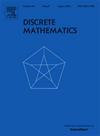Collatz高周期不存在
IF 0.7
3区 数学
Q2 MATHEMATICS
引用次数: 0
摘要
Collatz函数取奇数n到(3n+1)/2和偶数n到n/2。在迭代Collatz函数下,每个正整数都被推测在平凡循环1-2-1中结束。有两种类型的有理Collatz循环特别有趣。考虑一个集合S(k,x),它由长度为k的循环中x个奇数项的最小成员组成。电路包含S(k,x)中最小的成员,而高周期包含最大的成员。已知不存在正整数回路(除了1-2-1);本文还证明了正整数也不存在高环。本文章由计算机程序翻译,如有差异,请以英文原文为准。
Collatz high cycles do not exist
The Collatz function takes odd n to and even n to . Under the iterated Collatz function, every positive integer is conjectured to end up in the trivial cycle 1-2-1. Two types of rational Collatz cycles are of special interest. Consider the set consisting of the smallest members of k-length cycles with x odd terms. The circuit contains the smallest member of , while the high cycle contains the largest. It is known that no circuits of positive integers exist (except 1-2-1); this paper shows that there are likewise no high cycles of positive integers.
求助全文
通过发布文献求助,成功后即可免费获取论文全文。
去求助
来源期刊

Discrete Mathematics
数学-数学
CiteScore
1.50
自引率
12.50%
发文量
424
审稿时长
6 months
期刊介绍:
Discrete Mathematics provides a common forum for significant research in many areas of discrete mathematics and combinatorics. Among the fields covered by Discrete Mathematics are graph and hypergraph theory, enumeration, coding theory, block designs, the combinatorics of partially ordered sets, extremal set theory, matroid theory, algebraic combinatorics, discrete geometry, matrices, and discrete probability theory.
Items in the journal include research articles (Contributions or Notes, depending on length) and survey/expository articles (Perspectives). Efforts are made to process the submission of Notes (short articles) quickly. The Perspectives section features expository articles accessible to a broad audience that cast new light or present unifying points of view on well-known or insufficiently-known topics.
 求助内容:
求助内容: 应助结果提醒方式:
应助结果提醒方式:


